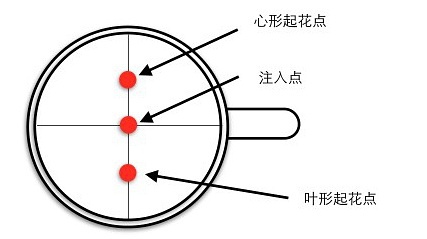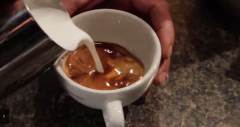How to get started with professional baristas? Translation of the Handbook of Professional baristas (1)

For professional baristas, please follow the coffee workshop (Wechat official account cafe_style)
How to get started with professional baristas?
Start with coffee beans.
Many people think that knowing how to mix a cup of coffee is tantamount to putting coffee powder into a cup and then mixing it well with water and milk. In fact, this is a very common misunderstanding that makes people think that baristas are an easy industry to enter. As a matter of fact, baristas can be called professional baristas only if they have a basic understanding of coffee, and they must also have an understanding of the techniques and tools of cooking and coffee beans.
Watch the beans in the micro
To get to know coffee, we should first start with raw coffee and raw beans. The origin of coffee beans comes from different countries, and coffee trees grow in different places, there will be differences in quality. Coffee beans are mainly divided into two types: Arabica and Robusta. High-quality Arabica is mostly planted in highlands above 1000 meters above sea level, while Robusta with strong adaptability is planted in areas below 1000 meters above sea level. The acidity and bitterness of each kind of coffee beans are different. It is necessary to understand their characteristics before you can cook a cup of coffee that suits the taste of the guests.
Coffee beans will change with humidity, light, air, temperature and other factors, so baristas must know how to "look at the beans." According to the daily state of coffee beans, baristas should use coffee machines and bean grinders to make appropriate adjustments to the roughness and powder content of coffee beans.
Knowledge + technology
In fact, in addition to brewing coffee, baristas have other jobs to take care of. When entering the job, you will start with basic catering operations, such as cleaning, service skills, communication, daily operation and necessary coffee brewing skills.
In addition, of course, you should take care of all the work in the coffee bar, such as cleaning and shopping, and so on. Knowledge is important, technology is important, responsibility is important, and another key task is to communicate with guests and use their own professional knowledge to make the coffee that best suits the guests' preference.
International qualifications pave the way for entry into the industry
With the popularity of coffee culture, drinking coffee is not only for refreshing, but also the pursuit of taste. At present, in addition to chain coffee shops, boutique coffee shops have also opened into the market, in order to win by quality and attract demanding coffee lovers. As a matter of fact, customers pay more attention to quality than ever before, so baristas must possess professional knowledge and skills in order to satisfy their "picky" taste. As the industry is becoming more and more professional, baristas will have greater opportunities for development if they can obtain internationally recognized qualifications.
There is a market for boutique coffee
In chain coffee shops, customers can only choose the specified taste from the menu. The selling point of boutique coffee shops is that they pay more attention to the variety, freshness and baking methods of coffee beans, as well as the skill frame of baristas, which is very popular with coffee fans. The reason why many people patronize boutique coffee shops is to taste a cup of coffee that suits their own taste. At present, most boutique coffee shops operate on a small scale, and baristas from some chain stores do not hesitate to change jobs to small shops to increase their understanding of boutique coffee. However, large coffee shops also have a "boutique" trend, so employees have more access to boutique coffee than before.
International qualifications are getting more and more attention.
The popularity of boutique coffee has undoubtedly made the coffee industry more diversified. Baristas must constantly upgrade themselves in order to cater to the preferences of different customers. Many baristas start from a low level, but their knowledge may be limited to the level involved in their work, and they may not necessarily have the opportunity to acquire a comprehensive knowledge of coffee.
If you want to become a professional barista, in addition to learning while doing, you can also pave the way for further study. At present, there are different coffee certificate courses to choose from, but the internationally recognized ones are SCAA (Specialty Coffee Association of America), SCAE (Specialty Coffee Association of Europe) and City and Guilds. City and Guilds offers a "International Coffee Blender skills qualification course". Through 20 hours of training, trainees can learn coffee knowledge, coffee machine operation, beverage blending skills (including coffee, chocolate, tea and smoothies) and customer service skills. Upon completion of the course and assessment, you will be qualified as a coffee dispenser.
Professional barista Handbook
Author: Scott Rao
Uncle Dewa
The first chapter is ready to begin.
Equipment
In this book, we will experiment and make coffee with different parameters. In order to make full use of the skills recommended in this book, please prepare the following equipment.
A commercial or household (professional quality) Italian machine.
A commercial or household Italian mill.
A powder hammer that fits the size of the powder bowl.
A handle with a bottomless powder bowl.
Unnecessary but useful tools: Scace Thermofilter (temperature measuring handle), timer, thermometer, electronic scale.
Standard
The definition of "A Shot" Espresso may vary from country to country and for different baristas. In this book, a single Espresso will be defined according to the following parameters (Note 1: the traditional method of measuring Espresso components is volume measurement, but in fact the method of weight measurement is more effective. Volumetric measurements will cause errors due to changes in Crema, and the multiplicity of Cream will distort your judgment of the amount of liquid in Espresso (see "Powder / Water ratio and Standard of Espresso" in Chapter 3):
The above standards are not recommended and only represent common practices at present. Please refer to the appendix for more information on coffee, tea, Espresso and water quality standards.
Some basic terms
"extraction" is the extraction of substances from coffee powder, which contain soluble and insoluble substances.
Whether it's drip coffee or Espresso, "soluble matter" refers to the extraction of solids and gases from the liquid. Soluble solids affect the taste of coffee (Taste), while soluble gases and volatile aromatic hydrocarbons affect the aroma of coffee (Aroma).
The "insoluble matter" in drip coffee contains solids and suspended oils. Insoluble solids are mainly composed of macromolecular proteins and fiber fragments of coffee beans. The combination of insoluble solids and oils will form colloids. They affect the aroma (Aroma), alcohol thickness (Body) and taste (Taste) of coffee, and reduce the acidity and change the flavor trend by preventing or delaying the release of soluble solids and gases.
The "insoluble matter" in Espresso includes suspended solids and emulsified liquids. The suspended solids are mainly composed of coffee bean cell wall fragments, which only affect the alcohol thickness (Body), but have nothing to do with the flavor (Flavor). Emulsified liquids are tiny droplets of oil wrapped in liquids that enhance the aroma (Aroma), alcohol thickness (Body) and taste (Taste) of coffee, and can also be wrapped on the tongue, reducing the perception of bitterness. (note that when 2:Espresso is made into American coffee (Americano), it becomes more bitter because the added hot water dilutes the density of the oil, so that the oil cannot be completely wrapped on the tongue).
Chapter II Espresso
Espresso is small in volume, high in concentration and made according to fixed standards. It includes liquid and top-covered foam (Crema). Both liquid and Crema parts are composed of emulsions, suspended solids and solutions.
The main body of Crema is carbon dioxide and water vapor wrapped in a liquid membrane. Crema also contains suspended coffee bean cell wall fragments and ultra-fine powder (which is why "tiger lines" or spots are formed), as well as emulsified oils that store aromatic substances.
Therefore, the liquid phase of Espresso includes soluble solids, emulsified grease, suspended fine particles, and active bubbles.
Espresso extraction: primary
The following will do an overview of Espresso extraction, this section is not intended to do a comprehensive technical discussion, only a brief introduction of the basics.
Basic knowledge
Espresso is made by filtering pressurized hot water through a pressed fine ground coffee pressed powder. Hot water forces the solids and grease out of the coffee particles and sinks into the cup through the powder bed.
The speed of water flowing through the powder bed depends on the pressure of the coffee maker, the amount of coffee powder, and the fineness of the coffee powder. The higher the pressure, the faster the flow rate; on the contrary, the flow rate slows down. The use of a large amount of coffee powder or a fine grinding degree will cause greater resistance to the flow of water, thus slowing down the flow rate.
The current always looks for the path with the least resistance to cross the powder bed. So the barista's task is not only to create appropriate flow resistance, but also through the distribution of powder, so that the whole powder bed can produce uniform resistance to the flow of water. The powder bed with poor cloth powder is easy to produce a channel, and the water will flow through the powder bed at high speed from the channel.
The channel will affect the concentration and flavor of the coffee. If the amount of water passing through the channel is too large, the product will be diluted and the coffee powder along the channel will be excessively extracted, resulting in increased bitterness. At the same time, due to less water passing through the high-density areas of the powder bed, these areas will be underextracted (Note 1: "over-extraction" and "under-extraction" are subjective. I use these two terms, it does not mean that coffee, tea and Espresso have a universally accepted standard of perfect extraction rate. Readers can understand "over-extraction" as a general reference for higher-than-expected extraction rates, usually excessive bitterness and astringency. "insufficient extraction" means that the extraction rate is lower than expected, which usually leads to incomplete flavor development of the final product, resulting in incomplete flavor development and lower concentration. In order to minimize the channel effect, baristas should make the surface of the powder bed smooth and smooth, just like forming a uniform and airtight wall in the powder bowl.
To check the channel, you can observe it through a bottomless powder bowl, but not necessarily every time. The channel shows that the flow rate of the extracted liquid in one area is faster than that in other areas, or the color becomes lighter faster than in other areas.
The role of a barista
Before making an Espresso, a barista should complete the following preparations:
The amount of powder used in each Espresso is the same.
The grinding degree of coffee powder is selected according to the expected flow resistance.
Spread the coffee powder evenly to form a consistent flow resistance.
Press the powder with sufficient strength to remove the gaps in the coffee powder bed and seal the surface of the powder bed.
Ensure that the cooking water reaches the expected temperature.
Be able to accomplish all of the above efficiently.
The role of bean grinder
The bean grinder is the most important part of the Espresso bar. The glow of the grinder is usually overshadowed by the more expensive and brighter espresso machine, but the quality of the grinder is arguably the most important factor in the Espresso preparation phase.
A high quality bean grinder must be able to:
Produce particles of appropriate thickness to provide sufficient flow resistance.
The particle size distribution of the bimodal curve (or triple peak curve) is produced (see "Espresso Grinding" in this chapter for details).
Minimize the heat generated by grinding when grinding beans.
Limit the production of ultra-fine powder (fines).
Ultra-fine powder plays an important role in the extraction of Espresso, which will be discussed in detail in the third chapter. What we need to know now is that in the process of extraction, the flow of water will drive the ultra-fine powder to sink to the bottom of the powder bed, a phenomenon we call "ultra-fine powder displacement". When the ultra-fine powder and insoluble large protein molecules precipitate together at the bottom of the powder bed, they combine to form a dense layer or lump solid. This dense layer will block the outlet at the bottom of the powder bowl, resulting in clogged flow paths, uneven flow resistance, and channel effects. An appropriate amount of ultra-fine powder is what we pursue, but excessive ultra-fine powder or ultra-fine powder displacement will reduce the quality of Espresso.
The shallow extract on the left indicates the existence of a channel effect.
The role of Italian Coffee Machine
The task of the espresso machine is to send water to the coffee powder at a predetermined temperature and pressure. Both the temperature curve and the pressure curve need to be set in advance.
A high-quality espresso machine, even in high-intensity use, should provide a consistent water temperature and pressure curve for each product.
Extraction stage of Espresso
1. Pre-immersion. After the pump is ready, the first stage of Espresso extraction is a short period of low-pressure pre-immersion (some machines skip this step and start directly from the second stage). In the pre-soaking stage, the coffee powder is slowly wet by low-pressure water, allowing the powder bed to adjust itself to create a more uniform flow resistance.
two。 Pressurization. The function of the second stage pressurization is to tighten the powder bed and speed up the flow rate of water. Machines without pre-immersion start directly from this stage, although such machines can also make a good Espresso, but they are more uncontrollable and have less room for adjustment for baristas.
3. Extraction. In the third stage, after the extraction begins, the Espresso liquid flows out of the powder bowl. The extraction is mainly accomplished by water scouring the coffee powder and eroding the solid substances in the surface layer of the coffee powder particles.
The first extracted liquid is dark in color and has a high concentration of solids. As the extraction process continues, the concentration of the liquid becomes lower and lower, and the color becomes lighter and lighter. During the extraction, the extracted material is continuously extracted from the powder bed in a top-down manner, so that the material at the top of the powder bed is extracted preferentially. As the extract passes through the powder layer, some precipitate to the bottom of the powder bed, some remain in the dense layer, and the rest flow into the cup.
Concentration and extraction rate of Espresso
The concentration of Espresso refers to the concentration of extracted solid substances, and the traditional Italian standard is 20-60 mg/ml (mg / ml). The extraction rate of Espresso refers to the specific gravity of the substance extracted from the coffee powder during the extraction process, and the solid substance accounts for about 90% of the extract of Espresso. Please note that when we discuss Espresso, we usually discuss the concentration and extraction rate of "solids", while when discussing drip coffee, we should pay more attention to the concentration and extraction rate of "soluble matter".
There is no direct correlation between concentration and extraction rate. For example, increasing the water temperature increases both the concentration and the extraction rate, while increasing the amount of water passing through the powder bed reduces the concentration but increases the extraction rate.
(chapter 2, Espresso grinding, filling and cloth powder, to be continued.)
Important Notice :
前街咖啡 FrontStreet Coffee has moved to new addredd:
FrontStreet Coffee Address: 315,Donghua East Road,GuangZhou
Tel:020 38364473
- Prev

Practical information | Translation of the Handbook of Professional baristas (2) Espresso grinding, powder filling and cloth powder
Professional barista communication please follow the coffee workshop (Wechat official account cafe_style) the second part of the introduction to professional baristas! Three keys to success when most coffee shop owners hire baristas, the most important thing is not a job seeker who is skilled in brewing coffee. They pay more attention to first impressions, including conversation, appearance and basic knowledge of coffee. When you successfully enter the profession
- Next

[you don't know coffee] Coffee beginner Q & A collection must be collected!
Professional barista communication Please pay attention to the coffee workshop (Wechat official account cafe_style) to become a coffee expert, we must first understand some basic knowledge, the following are coffee novice in the process of learning questions, now for everyone to sum up: [question set]: 1 I am a novice, suitable for drinking what kind of coffee? A: the taste of coffee is suitable for the new.
Related
- Beginners will see the "Coffee pull flower" guide!
- What is the difference between ice blog purified milk and ordinary milk coffee?
- Why is the Philippines the largest producer of crops in Liberia?
- For coffee extraction, should the fine powder be retained?
- How does extracted espresso fill pressed powder? How much strength does it take to press the powder?
- How to make jasmine cold extract coffee? Is the jasmine + latte good?
- Will this little toy really make the coffee taste better? How does Lily Drip affect coffee extraction?
- Will the action of slapping the filter cup also affect coffee extraction?
- What's the difference between powder-to-water ratio and powder-to-liquid ratio?
- What is the Ethiopian local species? What does it have to do with Heirloom native species?

